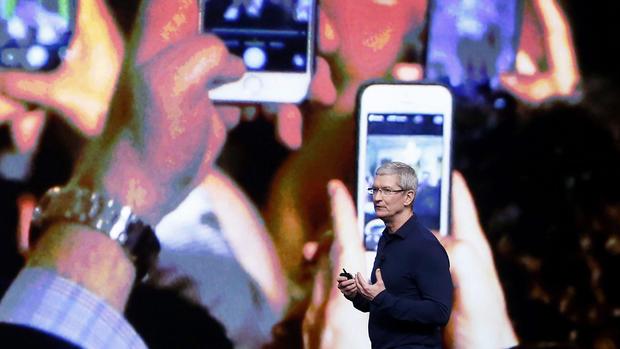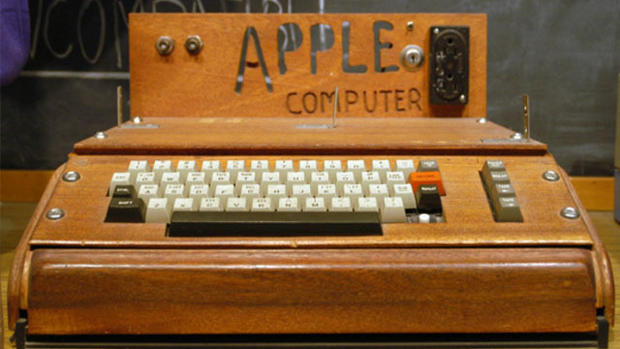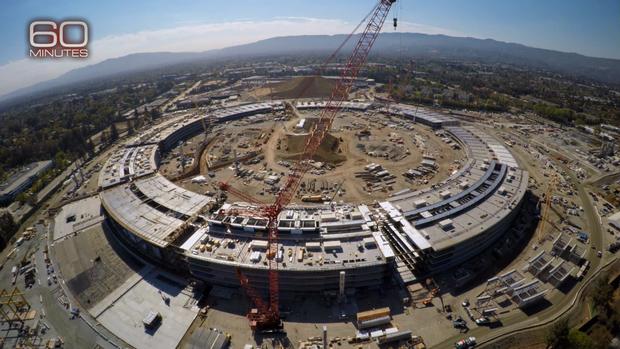Apple unveils iPhone 7, new Apple Watch and more
Aiming to reignite excitement about iPhones after seeing sales decline for the first time, Apple executives took the stage at San Francisco’s Bill Graham Civic Auditorium on Wednesday to unveil the company’s latest generation of devices.
The debut of iPhone 7
The most highly anticipated launch of the day was the new iPhone 7, which will be priced starting at $649. Customers can pre-order the iPhone 7 and larger iPhone 7 Plus starting Sept. 9, and phones will ship Sept. 16.
The new model is the first water-resistant iPhone. It comes with stereo speakers and has a longer battery life than any previous model. Specifically, Apple said iPhone 7 users can browse on Wi-Fi for 14 hours straight, while iPhone 7 Plus users should get 15 hours of browsing time. On average, the iPhone 7 lasts two more hours than the iPhone 6S, the company said.
In a massive shift — celebrated by some and dreaded by others — the new iPhone 7 will do away with the headphone jack as we know it. Instead, Apple is including an adapter for older headphones to be plugged into the Lightning port. New wireless earbuds called AirPods — a leap towards a “wireless future,” the company said — will hit the market in October for $159.

In another move long anticipated by industry insiders, the iPhone 7 Plus will have two camera lenses with the capacity to zoom without losing resolution — mimicking a professional telephoto lens. The phone’s camera includes an optical image stabilizer, a wider lens, an all-new flash that can recognize artificial lighting, video stabilization, wide color capture, and a high-speed sensor.
The iPhone 7’s new chip, which Apple called a “rocket ship,” boosts its processing performance to 120 times faster than the original iPhone, the company said.
The phone comes in two new shades of black: one is simply called “Black” and the other, featuring a glossy finish, is called “Jet Black.”
Storage options are changing, too: the new iPhone starts with a more generous 32GB, up from 16GB. (128GB and 256GB options will also be available.)
Screen sizes remain the same as last year’s model – 4.7 inches for the iPhone 7 and 5.5 inches for the iPhone 7 Plus. The iPhone 6s and 6s Plus, and the 4-inch iPhone SE, will also remain available at lower prices.

Apple CEO Tim Cook praised the iPhone 7’s operating system, iOS 10, as the “world’s most advanced mobile operating system.” The new system boasts several new features, including a home management tool called Apple HomeKit and redesigned maps that allow users to book rides and reservations from within. The phone can be woken up from sleep simply by lifting it, Cook said. The operating system will be released Sept. 13.
The new Apple Watch, Series 2
The company announced the next generation of smartwatch it’s calling the Apple Watch Series 2. The watch will be priced at $369 and can be pre-ordered Sept. 9, 2016.
Users can wear the new Apple Watch confidently in the water, the company said of its new water-resistant casing. It also boasts Apple’s brightest-ever display.
CNET editor Scott Stein praised the tweaks to Apple Watch’s operating system, Watch OS3, which will be available starting Sept. 13. “WatchOS 3 does a lot to make the Apple Watch better. I’ve used it a little, it speeds a lot up,” Stein said.
Several new Apple Watch features include stickers, activity sharing, integrated GPS, a new mindfulness app called “Breathe,” and a built-in safety feature to contact emergency services wherever you are.
In a nod to the gaming phenomenon no one saw coming, Apple COO Jeff Williams also confirmed that Pokemon Go is coming soon to Apple Watch. The original Apple Watch will now be known as the Series 1 and will get a boost from the same dual core processor as Series 2, with prices starting at $269.
Music and games
In a lighthearted video with “Late Late Show” host James Corden, Cook belted out a few songs and revealed that some new episodes of Corden’s viral series, in which he sings karaoke with public figures from Adele to First Lady Michelle Obama, will premiere on Apple Music in 2017.

Apple’s event also included some nostalgia: Mario Kart is coming to the iOS App Store, Cook said. The game, Super Mario Run, is the first traditional Nintendo game for smartphones, exclusive to iOS.
“There’s been something - or someone - missing: And I’m so happy to announce today he is coming to the App Store. Welcome, Mario,” Cook said.
The hour-long Apple event wrapped up with more music: a live performance from Sia.
Rumors and reaction
In keeping with Apple tradition, plans for Wednesday’s event were cloaked in secrecy. A cryptic invitation issued last week revealed no clues about what would be announced. (“See you on the 7th” was all it said.)
However, a steady dribble of leaks managed to undermine much of the suspense.
Just an hour before Wednesday’s launch, Amazon prematurely published its product page for iPhone 7 accessories, which included a photo of the new phone, before quickly taking it down. The page was up long enough to confirm what bloggers had reported for months – that Apple was eliminating the standard headphone jack in order to make the phone thinner and more water-resistant.
The headphone reports, apparently fed by insiders in Apple’s supply chain, prompted a wave of complaints from users unhappy about the prospect of having to replace or buy an adapter for their expensive headphones.
“Taking the headphone jack off phones is user-hostile and stupid,” ranted Nilay Patel on The Verge. “The traditional headphone jack is a standard for a reason – it works. It works so well that an entire ecosystem of other kinds of devices has built up around it.”
However, as with other initially unpopular changes to familiar products, CNET’s David Carnoy believes consumers will get used to it and eventually see the advantages. “Wireless headphones are the future,” he wrote.
Aside from the headphone issue, most experts sought to keep expectations in check.
“If you’re looking to be wowed by a new iPhone design, you might have to wait until 2017,” said CNET’s Shara Tibken.

Apple provided a preview of iOS 10 at its Worldwide Developer Conference (WWDC 2016) in June, announcing that the new operating system will retire the familiar “slide to unlock” function, and expand the use of Siri.
Those software updates may actually be more significant than any tweaks to the device itself. “We haven’t seen the dramatic changes in device features that we did perhaps just three or four years ago,” tech research analyst Jordan McKee told CBS News’ John Blackstone. “Really it is about the software that is going to drive sales of new devices.”
A more substantial overhaul could come next year, as the iPhone marks its 10th anniversary.
Last year’s models, the iPhone 6s and iPhone 6s Plus, were the first to incorporate “3D Touch,” enabling the screen to offer different functions in response to a quick tap or a longer touch. The phones also included an improved 12-megapixel camera and a faster chip. However, there were only minimal adjustments to the iPhone’s now familiar design.
Market challenges
Wednesday’s press event was the first for the company since March, when it introduced the smaller-sized and lower-priced iPhone SE as well as a 9.7-inch version of the iPad Pro.
It came just weeks after Tim Cook celebrated his fifth anniversary as Apple CEO, a period marked by financial success but lacking the type of game-changing technological innovations his predecessor Steve Jobs was famous for.
Earlier this year, Apple reported the first quarterly decline in iPhone sales in its history, and profits fell 27 percent.
Apple is aiming to regain smartphone market share from rivals like Samsung, which is number one worldwide – boosted by sales of its popular Galaxy S7 phones – and Huawei, which dominates the growing market in China. Industry analyst IDC reported iPhone sales were down 15 percent in the second quarter of 2016 compared to the year before, though that may be in part because consumers hold out for the new models in the fall.
In addition to facing fierce competition from increasingly sophisticated Android phones, Apple needs to convince its own users that the iPhone 7 is worth upgrading for.

“I think the big threat to Apple is the potential that people hold their phones longer, which we think is happening to a certain extent, and that they start to look at the cheaper iPhones and say, ‘well, that’s good enough,” analyst Andy Hargreaves of Pacific Crest Securities told CBS News.
This time last year, sales of the 6s and 6s Plus started off strong, with Apple reporting 13 million sold in their first three days on the market – topping the record of 10 million set the year before with the iPhone 6.
The company sold its one billionth iPhone in January 2016.
But the ubiquity of smartphones has created a new challenge for the company. As CNET senior editor Scott Stein put it: “We’ve hit a wall for how many people might reasonably get smartphones: it can’t all be about the iPhone.”
CBS News’ Blackstone reports some analysts see big growth potential in Apple’s online services like iCloud, iTunes, Apple Pay, and the App Store.
“When it’s these services that are out there that are every month, just little slivers of money that have good value for people, that’s a great revenue stream for Apple, and it’ll just keep getting bigger and bigger and bigger,” said Neil Ticktin, organizer of the MacTech Conference and editor-in-chief of MacTech Magazine.
- Watch CBSN for highlights and analysis
-
Follow CNET’s live blog of the Apple event
- Complete coverage of Apple on CNET
- In:
- Tim Cook
- iPhone
- Apple Watch
Shanika Gunaratna covers science and technology for CBSNews.com
TwitterDisclaimer: The copyright of this article belongs to the original author. Reposting this article is solely for the purpose of information dissemination and does not constitute any investment advice. If there is any infringement, please contact us immediately. We will make corrections or deletions as necessary. Thank you.






